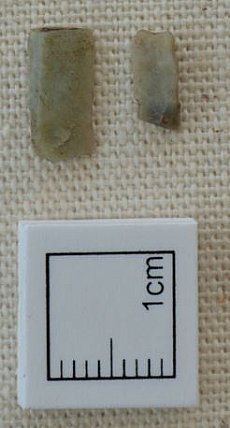Mesolithic bloodstone artefacts from Camas Daraich, Skye
07 August 2020
- News Type:
- Find of the Month

© Beverly Ballin Smith
Bloodstone is a form of jasper (chalcedony) which outcrops on the island of Rum, to the south of Skye. It was used in prehistory, particularly in the Mesolithic period, to knap into tools. Despite its name, bloodstone is rarely red when found. It is not easy to knap, so its prevalence must in part be due to ease of collection. Its limited source location makes it a very useful indicator of movement and exchange.
These bloodstone objects were found at Camas Daraich, southern Skye, a short sail from the source. In the 7th millennium BC, a lithic working site was situated on the raised beach. A small excavation and surface collection in 2000 recovered almost 3000 lithics, as well as charcoal and carbonised hazelnut shells; unburnt organic materials did not survive. The objects included a number of microliths, scrapers, points and a great deal of debitage from knapping. Raw materials consisted of 46% chalcedonic silica, 33% bloodstone and 19% quartz, with small amounts of other material; due to the similar geologic components it is possible that some of the chalcedonic silicas are also bloodstone.

© Beverley Ballin Smith
There has been a great deal of discussion on the chronology of broad and narrow blade microliths. The examples from Camas Dariach vary from 4 to 21 mm, with no distinction by raw material. Overall the dimensions compare fairly closely to Kinloch, Rum, a Mesolithic site composed predominantly of local bloodstone lithics. Microwear analysis was carried out on the lithics, providing a useful insight into use. Of the artefacts examined, over half of the bloodstone pieces had visible traces of use, perhaps suggesting preferential selection for tasks. Some unretouched flakes and blades also showed evidence of use, an insight important when assessing importance of artifacts recovered from investigations.
The radiocarbon dates show activity in the 7th millennium BC, part of a growing number of sites in the area showing human activity at this early period including Kinloch, Rum, An Corran and Loch a Sguirr rockshelter on Skye, and Sand, Wester Ross. There are hints that later activity took place, including into the Bronze Age, again not unusual in other Highland Mesolithic sites. While most bloodstone lithic material appears to date to the Mesolithic, there are also some examples of later use in the Neolithic and Bronze Age.

refer to Ballin 2018
Map prepared by Fiona Jackson; ©
Torbin Bjarke Ballin
Bloodstone artefacts are found in an area of c. 80 km from Rum, with a few outliers. Lithics from sites closest to source, such as those on Rum itself are predominantly made of bloodstone, while the proportion generally tapers off with more distance. Some of the lithics at Camas Daraich were made from baked mudstone, another raw material with distinct source known, in this case at Staffin on the north of Skye, some 70 km away.
Most of the worked lithics at Camas Daraich show remains of the cortex, suggesting they were knapped from pebble nodules. This suggests the raw materials were imported, rather than finished artefacts. However, the bloodstone objects show less cortex than more local materials, indicating that some testing and selection occurred before transport from source
The evidence from Camas Daraich, and other Mesolithic sites in the area, for example at Sand, Wester Ross and An Corran, Skye, show that raw materials were collected or exchanged, but in a relatively limited area. This contrasts with other raw material such as Yorkshire flint and Arran pitchstone which spread hundreds of kilometres. The nature of this exchange network, direct or indirect, can only guessed at, but are useful discussions. Was the bloodstone distribution part of the same network as baked mudstone from northern Skye, which may of course have also included organic materials?
The finds are important for several reasons. The site is evidence of early activity in the Mesolithic. It shows movement of raw materials by boat from the island of Rum at this period. It also shows the value of microwear analysis which is not as common as it ought to be.
The finds are in the Museum of the Isles, Armadale Castle
Further information:
Ballin, Torben Bjarke 2018 ‘The procurement of Rhum bloodstone and the Rhum bloodstone exchange network – a social territory in the Scottish Inner Hebrides’, Archäologische Informationen 41, 2018, 241-254. (available to download online)
Wickham-Jones Caroline R 2009 ‘5 Lithic raw material use around the Inner Sound’ in Hardy, Karen and Wickham-Jones, Caroline (eds) 2009, ‘Mesolithic and later sites around the Inner Sound, Scotland: the work of the Scotland’s First Settlers project 1998-2004’, Scottish Archaeological Internet Reports 31.
Wickham-Jones, Caroline R and Hardy, Karen 2004. ‘Camas Daraich: A Mesolithic Site at Point of Sleat, Skye, Scottish Archaeological Internet Reports 12
Highland Council HER MHG36657
Find of the Month Archive
- 25/07/2022 Steatite Vessels
- 10/04/2021 Cruisie lamp in Dunrobin Castle Museum
- 02/03/2021 Medieval Sword Pommel from Sleat, Skye
- 01/02/2021 Hilton of Cadboll Pictish Cross Slab
- 04/01/2021 Gunflint from Stoneyfield, Inverness
- 02/12/2020 Bobbin from Contin Bobbin Mill
- 02/11/2020 Russian Lead Cloth Seal from Cromarty
- 01/10/2020 The Poolewe Hoard
- 04/09/2020 Storr Rock Viking Silver Hoard
- 07/08/2020 Mesolithic bloodstone artefacts from Camas Daraich, Skye
